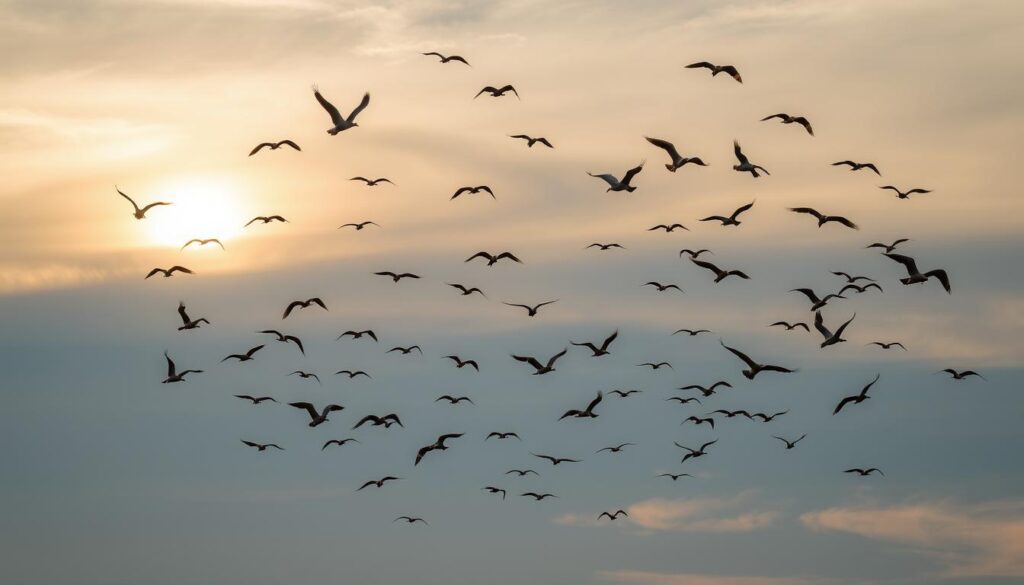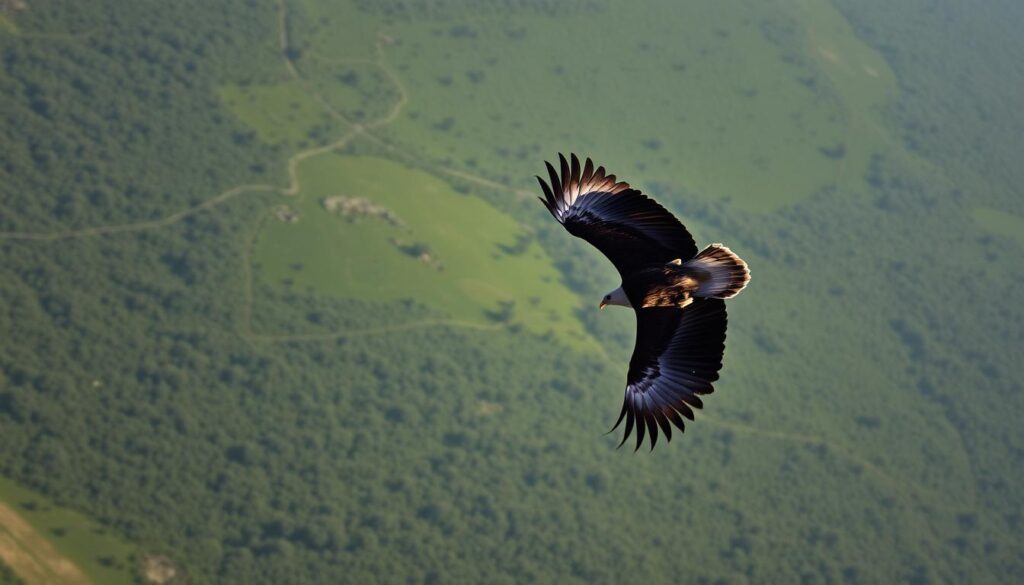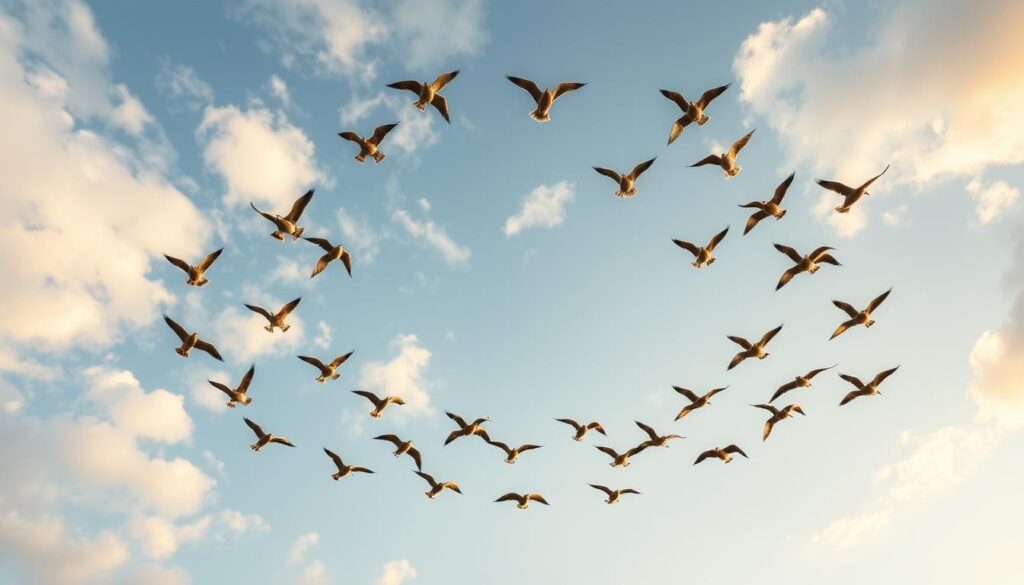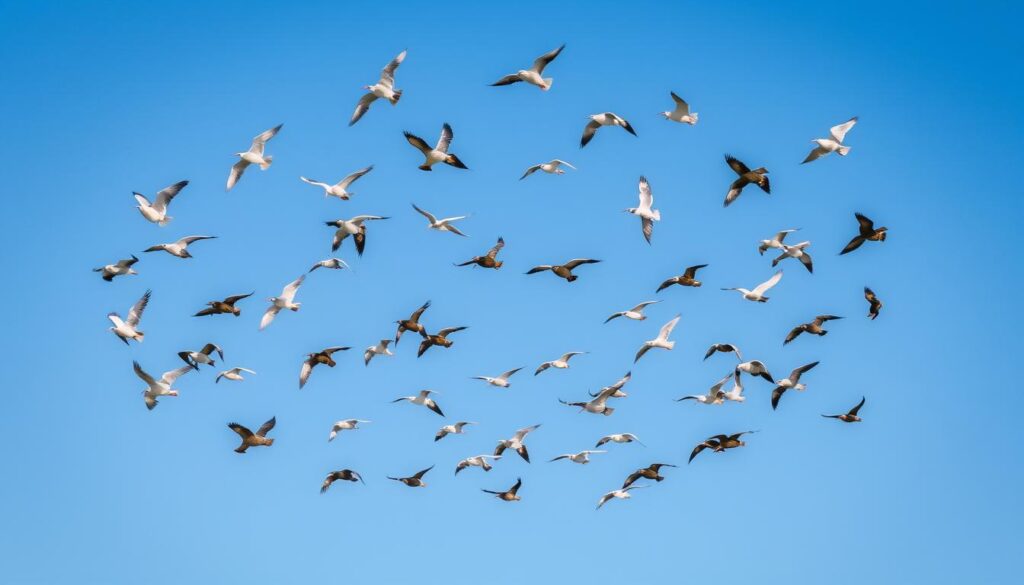Up to 750,000 starlings can fly together in a stunning circle called a murmuration. This amazing sight shows the complex flight patterns of birds. But why do birds fly in circles with such ease?
The secret to circular bird flight is in the science of how birds move through the air. They use rising warm air currents to soar. This way, big birds can fly for a long time without flapping their wings much.
Key Takeaways
- Birds, especially large soaring species, often fly in circular patterns to take advantage of thermal updrafts that provide lift and conserve energy.
- Murmurations, where thousands of starlings and sparrows form intricate circular flight formations, serve to protect the flock from predators.
- Circular flight patterns are commonly observed in birds of prey, such as hawks, eagles, and vultures, as well as pelicans during migration.
- The uneven heating of the Earth’s surface creates thermal columns that birds can use to gain altitude and soar efficiently.
- Group dynamics and social factors play a role in the complex circular flight patterns exhibited by many bird species.
The Science Behind Circular Flight Patterns
To understand why birds often fly in circular patterns, we must delve into the science behind their flight mechanics. The key factors that influence this behavior are the formation of thermal updrafts, the impact of air currents, and the role of temperature differences in the environment.
Understanding Thermal Updrafts
Thermal updrafts are created by the uneven heating of the Earth’s surface. This results in columns of rising warm air. Birds, especially soaring species like hawks and vultures, use these updrafts to gain altitude without using much energy. By circling within these updrafts, birds can save energy and reach higher heights. This gives them a better view of their surroundings.
How Air Currents Influence Bird Movement
In addition to thermal updrafts, air currents play a crucial role in shaping bird flight patterns. Birds navigate these air currents to save energy. By riding the air currents, birds can maintain their circular flight paths easily. This saves their energy for other important activities.
The Role of Temperature Differences
The temperature differences between different areas create thermal columns. Warmer air rises, and cooler air sinks. These temperature gradients act as natural “elevators” for birds. By circling within these columns, birds can gain altitude and maintain their circular flight patterns.
Understanding the science behind circular flight patterns is key to appreciating bird adaptations. By using thermal updrafts, air currents, and temperature differences, birds conserve energy. They can then soar effortlessly through the skies.
“Observations suggest that albatrosses soar in a characteristic swooping zigzag flight pattern, tightly coupled to wave crests.”
| Bird Migration Patterns | Percentage of North American Breeding Birds |
|---|---|
| Permanent Residents | Less than Half |
| Short-Distance Migrants | Undefined |
| Medium-Distance Migrants | Undefined |
| Long-Distance Migrants | More than Half |
Why Do Birds Fly in a Circle?
Birds fly in circles to save energy. They use thermal updrafts to climb high without much effort. This helps them during long bird migration, hunting, and finding food.
Thermals are warm air columns that rise from the ground. The sun’s heat makes the air above warmer and less dense. Birds like vultures, eagles, and hawks can sense these columns and fly up easily.
By flying in circles within thermals, birds can reach high altitudes with little effort. This energy conservation method lets them travel far with less fatigue. It also helps them hunt better and avoid predators.
The circular flight of birds shows their amazing adaptations. It helps them save energy and navigate better. They can also find more food in the sky.

“Birds are the ultimate masters of the sky, and their circular flight patterns are a testament to their evolutionary genius.”
The Physics of Avian Flight Mechanics
Birds can glide and maneuver through the air with ease. Their wings are designed to be highly efficient airfoils. The unique shape of their wings creates a pressure difference, allowing them to soar and save energy.
Wing Design and Aerodynamics
Bird wings are incredible feats of engineering. They have hollow bones and special feathers that help them fly. The wing’s shape creates a pressure difference, making lift. This lift, along with their lightweight bodies and efficient breathing, lets them fly effortlessly.
Lift Generation in Circular Flight
In circular flight, birds use thermal updrafts to lift themselves. These warm air currents help them save energy by reducing the need to flap their wings. By using natural forces, birds can soar without using too much energy.
Energy Conservation Principles
Energy saving is key to bird flight. Their lightweight bodies and efficient digestion help them fly with less energy. Techniques like thermal soaring and flying in V-formations also help them save energy during their travels.
| Bird Species | Flapping Technique | Energy Conservation |
|---|---|---|
| Albatross | Soaring | Can stay aloft for hours without a single wing beat |
| Hummingbird | Flapping | Can’t rest their wings for even a second in flight |
| Woodpecker | Swooping | Adapted for efficient flight patterns |
| Crow | Straight Line | Minimizes energy expenditure during flight |
| Swallow | Darting and Weaving | Agile flight patterns for hunting and foraging |
The amazing combination of avian aerodynamics, lift generation, and energy conservation makes bird flight incredible. By using natural forces, birds have evolved to fly effortlessly. This shows the amazing engineering of evolution.
Birds That Commonly Fly in Circles
The sight of birds flying in circles is truly mesmerizing. Certain species are known for their amazing flight skills. They include vultures, condors, and birds of prey, all showing incredible mastery of the skies.
Vultures and condors are famous for their circular soaring. They use thermal updrafts to climb high, looking for food. Eagles, hawks, and other birds of prey also fly in circles when hunting. They use their sharp eyes to spot prey from above.
Some migratory birds, like seabirds and waterfowl, fly in circles during their long trips. These circles help them save energy, rest, and navigate better.
The phenomenon of murmurations is another amazing example. Thousands of starlings or sparrows fly in synchronized circles. These patterns are thought to protect them from predators and help them fly more efficiently.
“The flying patterns of murmurations have more in common with physics than biology. Each starling in a murmuration is connected to every other starling, and when a murmuration turns in unison, it is considered like a phase transition.”
Some birds fly in circles to find shelter or prepare for storms. This shows their ability to adapt and respond to their environment.
The circular flight of vultures, birds of prey, and starlings is truly captivating. It gives us a glimpse into the amazing abilities of birds.

Understanding Thermal Soaring Behavior
Birds use thermal columns to soar through the sky. These columns of warm air rise when the sun heats the Earth unevenly. This helps birds climb high and save energy while flying.
Formation of Thermal Columns
Thermal columns form when the sun heats the ground. This warms the air above, causing it to rise. Birds take advantage of these columns to fly high.
The best conditions for soaring include clear skies and light winds. Also, areas with big temperature differences are key.
Optimal Conditions for Thermal Soaring
- Clear skies help the sun heat the air, making thermal columns strong.
- Light winds keep the columns steady, making them easier for birds to find.
- Big temperature differences between the ground and air make the columns rise.
Birds like large soaring species and birds of prey are great at finding thermal columns. They use these columns to fly high and cover long distances with little effort. Circling in the rising air, they save energy and soar effortlessly.
“Birds, like American white pelicans, provided data for estimating updraft speed in thermals and determining boundary-layer depth.”
By watching soaring birds, researchers have learned a lot. They’ve studied how pelicans fly to understand thermal columns better. This knowledge helps us know more about how birds fly efficiently.
The Role of Wing Structure in Circular Flight
Birds’ unique wing structure is key to their circular flight. Birds like vultures and pelicans, with long, broad wings, are great at soaring. They use thermal updrafts to their advantage.
The shape and size of a bird’s wings affect its flight. Hummingbirds, for example, flap their wings up to 80 times a second. This lets them do complex aerial moves and fit into tight spaces. Larger hummingbirds are better at speeding up or slowing down while turning, thanks to their bigger wings and muscles.
Adaptations like light organs and streamlined feathers help birds fly better. The wing’s shape is crucial for lift, creating different air pressures above and below it. This is essential for bird flight.

Bird flight combines gliding, flapping, and managing drag forces. Birds stretch their wings during flight, using specific muscles. The flexibility and arrangement of feathers help adjust flight patterns.
Understanding how a bird’s wing structure affects its flight can help us design better small aerial vehicles. It also inspires new engineering ideas.
Migration and Circular Flight Patterns
Many migratory birds use circular flight patterns for their long journeys. This helps them save energy and navigate by landmarks. They also adjust their path based on what they see and feel around them.
Seasonal Migration Strategies
Before they migrate, birds often fly in circles. This way, they can easily travel long distances. They fly in circles to find thermal updrafts, which help them rise without much effort.
This saves their energy for the long trip ahead. It’s a smart way for birds to travel far without getting too tired.
Navigation Methods During Circle Flying
- Celestial cues: Birds use the sun, moon, and stars to stay on course.
- Magnetic fields: The Earth’s magnetic field acts as a compass for birds.
- Visual references: Birds use landmarks like mountains and rivers to guide their flight.
By using these methods, birds can travel long distances efficiently. They can change their path as needed, ensuring they reach their destination safely.
“Birds use a variety of navigation methods during their circular flight patterns, drawing on celestial cues, magnetic fields, and visual references to guide their long-distance journeys.”
Hunting and Foraging Through Circular Flight
Predatory birds like hawks and eagles are top-notch hunters. They use a special way to find food – flying in circles. This method lets them scan big areas without using too much energy.
These predatory birds can cover a lot of ground in their search for food. Their circular flight helps them find and chase prey. Their sharp eyes can spot movement from high up, making them great aerial hunters.
Scavenging birds, like vultures, also fly in circles to find carrion. They soar above the ground to spot dead animals. This way, they make sure to find food, helping the ecosystem by cleaning up dead matter.
| Predatory Birds | Scavenging Birds |
|---|---|
|
|
The skill of these birds in flying in circles shows their amazing adaptations. They use air currents to save energy while searching for food. This can be either living prey or carrion.

“The circular flight patterns of hawks and eagles are a testament to the evolutionary ingenuity of these predatory birds. By seamlessly integrating their hunting skills with the principles of aerodynamics, they have mastered the art of aerial hunting and foraging behavior.”
Weather’s Impact on Bird Flight Patterns
The weather greatly affects how birds fly. Birds change their flight to better navigate their surroundings. This includes how they fly before a storm and how wind and temperature influence their flight.
Pre-storm Flight Behavior
Birds can sense when a storm is coming. Before a storm hits, they might fly in circles. This helps them find safe places to hide.
Wind and Temperature Effects
Wind direction and speed affect thermals and updrafts. These are important for birds to soar and glide efficiently. Temperature changes also impact the air currents birds use for flying.
| Weather Condition | Observed Bird Behavior |
|---|---|
| Fair Weather | Birds flying high in the sky, hawks soaring high, geese flying at higher altitudes |
| Impending Storm | Birds flying low, seagulls moving inland, fowl roosting during the day, birds becoming quiet |
| Approaching Fair Weather | Birds singing in the rain, crows flying in pairs, geese walking east and flying west |
It’s important to understand how weather affects bird flight. By studying these behaviors, we learn how birds adapt to different environments. This knowledge helps us appreciate their amazing abilities.
Energy Conservation in Bird Flight
Birds have developed amazing ways to save energy while flying. They use circular flight paths and thermal updrafts to cut down on energy use. This is especially helpful for birds that migrate long distances or soar for hours.
Migrating birds have special features that help them save energy. They have bigger hearts and more hemoglobin in their muscles. This helps them carry more oxygen. They also use fat as their main energy source, which is very efficient.
The way birds fly is also key to saving energy. Flapping their wings is more expensive than running, but flying is faster. This makes flying more efficient for birds. This principle helps birds save energy while in the air.
Birds also adjust their wing size and shape to save energy. Larger birds soar with smaller wing hands, while smaller birds have bigger hands for tight spaces. This change affects how well they fly and how much energy they use.

Birds have evolved incredible ways to save energy while flying. From their metabolism to their flight mechanics, birds are experts at conserving energy. This allows them to live in many different environments.
Group Dynamics in Circular Flight
The sight of bird flocks flying in circles is amazing. These patterns, called murmurations, have many uses. They help birds avoid predators and talk to each other. Studying these patterns helps us understand how birds work together.
Murmuration Patterns
Murmurations are especially seen in starling flocks. These swarms can have hundreds or thousands of birds flying together. They make beautiful shapes in the sky, thanks to their teamwork.
Social Aspects of Group Flight
These circular flights are not just pretty to watch. They help birds stay safe and find food. They also help birds know who’s in charge. Flying together also saves energy for the whole group.
| Flock Characteristics | Findings |
|---|---|
| Flock Size | The study focused on 41 releases of four pigeon flocks, each consisting of ten individuals. |
| Sampling Period | Three pigeon flocks (labeled as flocks A, B, and C) had 30 releases with a sampling period of 0.1 seconds. One pigeon flock (labeled as flock D) had 11 releases (ff1-ff11 free flights) from a different reference with a sampling period of 0.2 seconds. |
| Alignment Mechanism | The study observed that pigeons in flight did not frequently align with others but only occasionally, indicating an intermittent alignment mechanism. |
| Order Measurement | The index Ï• was used as a standard index of order during the study of collective animal behavior, where Ï• = 1/N∑(vi(t)/||vi(t)||) measured the degree of ordering in a flock. |
| Velocity Alignment | The study employed a quantity related to the instantaneous correlation with a time delay of two pigeons to quantify the intensity of velocity alignment between pairs of individuals. |
| Pairwise Interaction | The pairwise intensity of interaction was defined as the tendency of pairs to align their moving directions. |
| Time Delay Consideration | Interactions in pigeon flocks were based on previously perceived information, with the index τ representing the time delay considered in the measurements. |
Studying bird flocks, murmuration, and group flight behavior is ongoing. It shows us how birds work together and adapt. As we learn more, we appreciate their teamwork and adaptability even more.
Adaptive Benefits of Circular Flying
Circular flight patterns in birds are key to their survival. They help birds save energy, find food better, and avoid predators. This behavior is a big part of how birds have adapted over time.
One big plus of circular flying is saving energy. Birds use wind and rising air to fly long distances without getting tired. This is especially helpful for birds that migrate long ways.
Also, circular flying helps birds find food more easily. They can look over more ground by flying in circles. This means they can eat better and stay healthy.
Another benefit is avoiding predators. Birds can quickly change direction in the air. This makes it harder for predators to catch them, helping them stay alive.
“The global flock structure identified in the study is termed the compound-V formation, which is considered an intermediary between cluster flocks of starlings and V formations of geese.”
Birds use wind and rising air to fly long distances without getting tired. This shows how well birds have adapted to fly over time.

In summary, circular flying is more than just efficient flying. It’s a survival strategy that helps birds thrive, save energy, find food, and avoid predators. Studying this behavior helps us understand how amazing birds are.
Common Misconceptions About Bird Flight
Many myths surround bird flight patterns. Some believe all birds fly in circles, while others think circular flight is only for hunting. Scientific research has debunked these myths, offering clear explanations for why birds fly the way they do.
Debunking Flight Pattern Myths
One myth is that birds always fly in circles. While some, like hawks and vultures, do, not all birds do. Many, including migratory songbirds, fly in straight lines. They use circular patterns to catch updrafts, saving energy.
Another myth is that birds only fly in circles to hunt. But they also use it for socializing, navigating, and saving energy during migration. The way birds fly is influenced by wind, temperature, and air currents.
Scientific Evidence and Research
Scientific studies have shed light on bird flight. They show how wing design, lift, and energy saving shape flight patterns. This research has helped clear up myths, giving us a better understanding of bird flight.
As we learn more about birds, it’s key to keep an open mind. By clearing up misconceptions and accepting scientific facts, we can truly appreciate the amazing flight abilities of birds.
| Myth | Fact |
|---|---|
| All birds fly in circles. | While some species, like hawks and vultures, commonly exhibit circular flight patterns, many birds, including migratory songbirds, fly in more linear patterns. |
| Circular flight is solely for hunting. | Circular flight is used for various purposes, including social interaction, navigation, and energy conservation during migration, not just hunting. |
“By dispelling common misconceptions and embracing the scientific findings, we can gain a deeper appreciation for the remarkable feats of flight that birds have mastered through millions of years of evolution.”
The Evolution of Flight Patterns
The evolution of circular flight patterns in birds is closely tied to their ability to soar and glide efficiently. Fossil evidence and studies of modern birds show how these patterns evolved over millions of years. They adapted to environmental changes and found new ecological niches.
The origins of bird flight date back to the middle and late Jurassic period, around 160 million years ago. The early bird-like species, Archaeopteryx, had a mix of dinosaur and bird features. This shows the gradual transition from dinosaurs to birds.
Feathers existed for tens of millions of years before birds could fly. Over 60 million years, different bird species learned to fly. This includes the fast hummingbirds and the soaring albatrosses. Their evolution shows how avian evolution and flight adaptations developed.
The Wright brothers were inspired by watching vultures glide in circles. They used the concept of wing-warping in their planes. This shows how prehistoric birds influenced human aviation.
“Birdflight as the Basis of Aviation” – Otto Lilienthal, 1889
Studying bird flight helps us understand how to fly better. The connection between nature and human technology is fascinating. It shows our ongoing interest in the mysteries of flight.

Conclusion
The circular flight patterns of birds are truly amazing. They show how birds save energy, navigate, and survive. From soaring raptors to the stunning murmuration of starlings, studying these patterns helps us understand bird biology and migration.
Research in bird behavior is key to learning about conservation and animal behavior. By looking into bird behavior, flight patterns, and avian adaptations, we see how birds adapt to different environments. This knowledge helps us appreciate their survival strategies and motivates us to protect them.
Exploring bird flight patterns connects us to nature. These beautiful displays remind us of the deep bond between humans and the natural world. They inspire us to see the world in a new light and to cherish its beauty.
FAQ
Why do birds fly in a circle?
Birds fly in circles to use thermals, warm air columns that lift them up. This helps them save energy while flying. They can soar for a long time without flapping their wings much.
How do thermals and air currents influence bird movement?
Thermals are warm air columns that rise due to uneven Earth heating. Birds climb up these columns to gain height and save energy. Air currents, including thermals and wind, greatly affect how birds move.
What are the benefits of circular flight for birds?
Flying in circles helps birds stay in thermals, saving them energy. This is especially helpful for long migrations, hunting, and foraging. It lets them fly longer without flapping their wings much.
How does wing structure affect a bird’s ability to fly in circles?
Bird wings act as airfoils, creating lift by air pressure differences. Their shape and structure are designed for efficient flight. Hollow bones and special feathers make them aerodynamic. Birds with long, broad wings, like vultures and pelicans, are best at soaring and using thermals.
What bird species commonly engage in circular flight patterns?
Birds like vultures, condors, eagles, hawks, pelicans, and some seabirds often fly in circles. They have large wingspans, perfect for soaring.
How do weather conditions affect bird flight patterns?
Weather changes how birds fly. Before storms, they might fly in circles to find safe places. Wind direction and speed also shape thermals and updrafts, affecting their flight.
What are the misconceptions about bird flight patterns?
Many believe all birds fly in circles or that circular flight is for hunting. But science shows different reasons for various flight patterns. It clears up myths about bird flight.
How has the evolution of circular flight patterns in birds been influenced?
The evolution of circular flight in birds is linked to their ability to soar and glide. Fossils and studies of modern birds reveal how these patterns evolved. They adapted to environmental changes and found new ecological niches.

